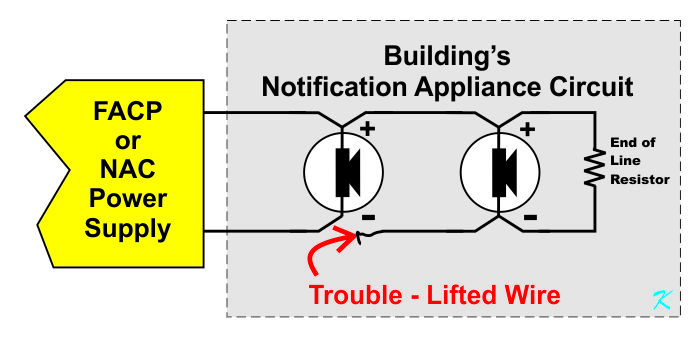How do I cause a trouble on a NAC circuit without breaking the circuit, should I be lifting wires?
Do not look at the color of the wire - the red wire can be either positive or negative and the black wire can be either negative or positive. Depending on the mode of the NAC circuit, the voltage polarity can be one way or the other. Instead of looking at the color of the wire, use your voltmeter to figure out the voltage polarity of the wires.
A conventional Notification Appliance Circuit (NAC) operates in two different modes:
- Sounding the Alarm
- Supervising the Wires (Checking for Electrical Continuity of The Wires)
Sounding the Alarm
When the fire alarm system is sounding the alarm, the voltage polarity on the wires for the NAC circuit is forward. When the voltage polarity is forward, the voltage pushes electrical current through the horns and strobes.
In other words, the horns and strobes are turned-on because electrical current passes through them.
Supervising the Wires
When the fire alarm system is not sounding the alarm, but supervising the wires, the voltage polarity on the wires for the NAC circuit is backward. When the voltage polarity is backward, a blocking diode inside each horn and strobe prevents any electrical current from passing through them.
In other words, the horns and strobes are turned-off because no electrical current passes through them.
Making Sure the Horns and Strobes are Connected
There's a problem, though. The horns and strobes don't have enough electronics in them to be able to tell the panel they are connected. But then again, in order to turn on the trouble light and buzzer, the panel has to know when anything is disconnected.
Normally, when all the horns and strobes are connected, there is a complete electrical path. The path goes from the panel, through the first positive terminal of a horn or strobe, through the next wire, through the positive terminal on the next horn or strobe, and so on. At the end of the circuit, the path goes through the end of line resistor.
After going through the end of line resistor, the path returns to the panel on the negative wire. The negative wire path also goes to the negative terminals on the horns and strobes, just like the positive wire goes through the positive terminals.
If the electrical path is interrupted anywhere, like a wire coming loose from a screw terminal or a wire breaking somewhere, the panel assumes that something is not going to work, and turns-on its trouble light and buzzer. At this point, the building owner calls for service.
Unsupervised Wires
Installers have been known to improperly install circuits. They have been known to install the end of line resistor at the panel, preventing the panel from performing the continuity check of the NAC wires. They also have been known to install T-taps in the wiring, preventing the panel from performing the continuity on the wires on the T-tap.
Usually, the wrong place for the end of line resistor or the T-tap in the circuit is there because the installer didn't know the reason for the end of line resistor.
See Class B Wiring -
https://www.douglaskrantz.com/BlogClassBWiring.html
Regardless of the reason, though, I have seen where the fire marshal is checking to make sure the circuit is installed correctly. An easy test for this is to disconnect a horn or strobe. The panel is supposed to turn on its trouble light and buzzer when a horn or strobe is disconnected.
When Something is Wrong
If, after disconnecting a wire, the trouble light and buzzer doesn't come on, something is wrong. Quite a number of times, I have had to trace out who has disconnected their fire horn in their apartment. The result of disconnecting the horn in the apartment is that half of the people in the building won't hear their fire horns when there's a fire.
- Because of the way it's wired, the NAC circuit showed trouble, and the owner called for service.
- If the NAC circuit isn't wired correctly, the owner won't know there's a problem. Then the problem isn't fixed until the system is tested, or when there's a real fire, whichever comes first.
- So that any problems can be fixed, the fire marshal just wants to make sure the NAC is wired correctly.
No, there is no other way of testing the wiring of the circuit without lifting a wire to "Break the Continuity of the Circuit".
Does NFPA 72 have a requirement on this?
In the Annex at the back of the NFPA 72, in their definition of Approved, it says "The National Fire Protection Association does not approve, inspect, or certify any installations ." The NFPA leaves that up to the AHJ.
- The National Fire Protection Association, Inc. is a publishing house. The NFPA produces guidelines for what constitutes a proper fire alarm system.
- The fire marshal is a representative of the government. The government makes the rules and laws that we are required to abide by.
Read:
Just Who Is the Authority Having Jurisdiction (AHJ)? to find out how the fire marshal fits into this.
Douglas Krantz
